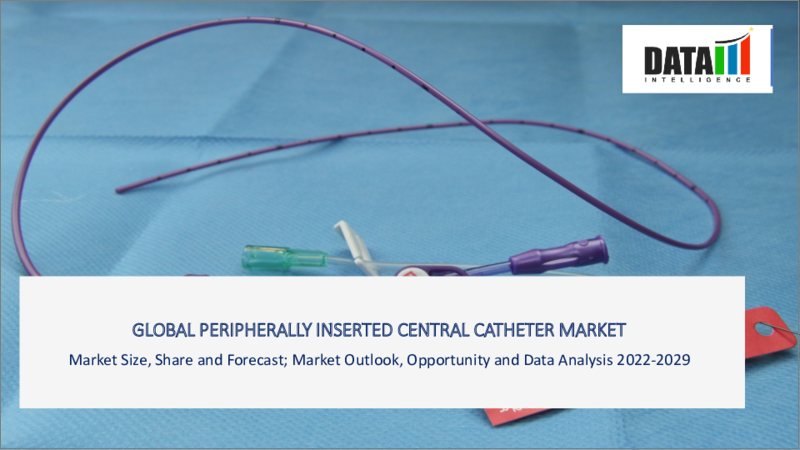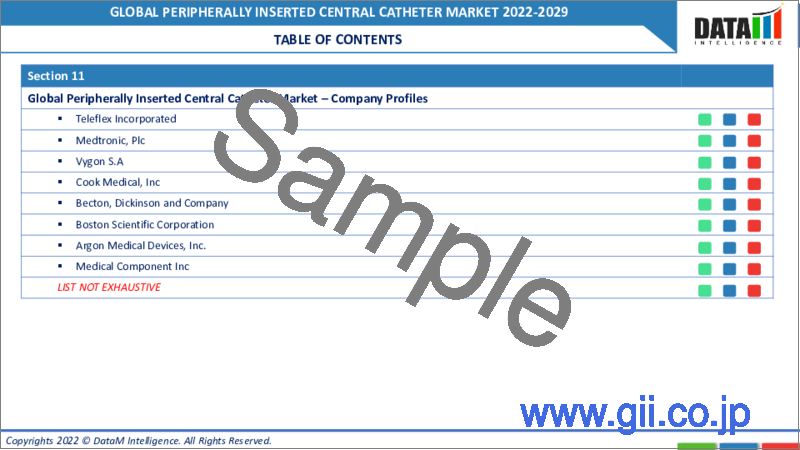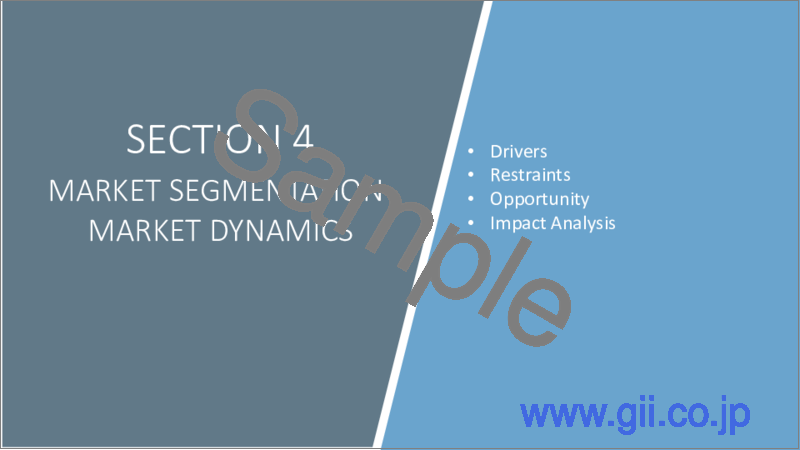|
|
市場調査レポート
商品コード
1143404
PICC(末梢挿入式中心静脈カテーテル)の世界市場-2022-2029年Global Peripherally Inserted Central Catheter Market - 2022-2029 |
||||||
|
● お客様のご希望に応じて、既存データの加工や未掲載情報(例:国別セグメント)の追加などの対応が可能です。 詳細はお問い合わせください。 |
|||||||
| PICC(末梢挿入式中心静脈カテーテル)の世界市場-2022-2029年 |
|
出版日: 2022年10月26日
発行: DataM Intelligence
ページ情報: 英文 200 Pages
納期: 約2営業日
|
- 全表示
- 概要
- 目次
市場の概要
PICC(末梢挿入式中心静脈カテーテル)の市場規模は、予測期間(2022-2029年)にCAGR5%で成長するとされています。
PICC(末梢挿入式中心静脈カテーテル)は、細くて柔らかい柔軟なチューブを上腕の静脈に挿入し、上大静脈と呼ばれる心臓の右側上部の大きな静脈に誘導(ねじ込み)するものです。この静脈ラインにより、静脈内投与が可能となり、検査用血液の採取も容易になります。
市場力学
PICCは他のカテーテルと比較して優れているため、医療従事者がPICCを使用する傾向が強まっていることが市場を後押ししています。また、慢性疾患の増加による入院の増加も、PICCの使用を増加させ、世界市場の成長を促進しています。
医療従事者のPICCに対する嗜好の高まりと慢性疾患の負担増が世界市場の成長を後押ししています。
医療従事者が通常の点滴ラインよりもPICCを好むようになったことが、世界市場の成長を後押ししています。なぜなら、通常の点滴よりも太く耐久性のあるPICCラインは、より細長く、静脈の奥深くまで入るなど、いくつかの利点があるからです。医療従事者は、通常の点滴ラインではなくPICCラインを使用することで、より長く(最長で3カ月、時にはそれ以上)留置することができ、採血のために針を刺す回数を減らすことができます。また、重篤な感染症で数週間抗生物質の点滴を受けたり、栄養剤の点滴を必要とする患者さんや、輸血を何度も必要とする患者さんには非常に有効な手段です。さらに、慢性疾患の負担が増していることも、PICCの使用を加速させています。例えば、WHOのデータでは、非感染性疾患(NCDs)により年間4100万人が死亡しています。2030年には5,200万人に増加し、8年以内に全死亡者の75%(世界全死亡者の74%)を占めると予測されており、70歳前にNCDで死亡する人は1,700万人以上、その86%が低・中所得国で発生しているとされています。さらに、世界レベルのNCDアライアンスによると、2011年から2030年の間に、心血管疾患、呼吸器疾患、糖尿病、がんの被害だけでも、世界全体で47兆米ドルの累積生産性損失が発生すると推定されています。
合併症と熟練した専門家の不足が、世界の末梢挿入式中心静脈カテーテル市場の成長を妨げています。
しかし、合併症や関連するリスクが世界市場の成長を抑制しています。例えば、カテーテルは、感染症、深部静脈血栓症(DVT)、血栓性静脈炎、脱落などの問題を引き起こす可能性があります。さらに、ラインの閉塞が遅かれ早かれ発生する可能性があります。重篤な合併症や治療の遅れは、病的状態の悪化や苦痛の増大、時には致命的な結果を招くこともあります。さらに、訓練を受けた専門家の不足が、世界市場の成長を妨げています。例えば、気胸、動脈穿刺、血胸、脳卒中、不整脈、神経損傷などの重大な合併症のリスクがあるため、チューブの設置は特別な訓練を受けた専門家が行う必要があります。
COVID-19の影響分析
COVID-19の期間中、ICUへの入院が急増し、血液サンプルの採取や栄養剤の点滴とともに薬剤の挿入のために中心静脈へのアクセスを長くする必要が生じました。また、COVID-19はARDSなので、機械式人工呼吸器が必要な患者さんでは、うつ伏せの体勢で酸素供給を強化することができました。うつ伏せの患者さんに入れる中心静脈カテーテルで最も難易度が低く、実現性が高いのは、上肢静脈のPICCです。したがって、COVID-19の流行期間中にPICCの売上が急増し、流行期間中の市場にプラスの影響を及ぼしました。
セグメント分析
パワーインジェクションPICCセグメントは、予測期間(2022-2029年)において高い需要があると予測されます。
パワーインジェクションPICCセグメントは世界の末梢挿入型中心カテーテル市場を独占し、予測期間(2022-2029年)中も支配的であると予測されます。PICCは、集中治療室での使用に適しており、高流量輸液、血行動態モニタリング、放射線検査時の造影剤の高圧注入など、あらゆる輸液に対応する多目的中心静脈ラインとして活用されています(レトロスペクティブレビュー研究による)。挿入は100%成功し、凝固障害のある患者でも大きなリスクを伴わないです。また、感染性・非感染性の合併症の発生率も極めて低く、維持管理も容易です。用途としては、高流量輸液、高圧注射、放射線治療中の血行動態モニタリングなどがあります。
地域分析
北米は、世界の末梢挿入式中心静脈カテーテル市場を独占すると予測されています。
北米は世界市場で最大のシェアを占めており、予測期間(2022-2029年)を通して優位に立つと予想されます。市場シェアの大部分を占める主要な市場プレイヤーの存在、病院数の多さ、高い医療費、老人人口の増加、がんや糖尿病、心血管疾患などの非感染性疾患の症例数の増加などが背景にあるためです。例えば、米国病院協会統計2022年報告書によると、2020年の財務データによると、米国の6,093病院、総人員920,531人のベッドが2020年に33,356,853人入院し、1兆2138億8100万1000米ドルの費用が発生していることが分かっています。また、メディケア&メディケイドサービスセンターによると、2020年の国民医療費は9.7%増の4兆1,000億米ドルに達し、国内総生産(GDP)の19.7%を占めます。
さらに、高齢者人口の増加に伴う非伝染性疾患の発生率の増加により、世界市場における北米の優位性が確保されています。米国国立がん研究所によると、2020年には、1,806,590人のがん患者が診断され、606,520人が死亡したと報告されており、米国がん協会2021年は、190万人以上ががんと診断され、608,570人が死亡したと推定されています。また、CDCによると、34秒に1人がCVSで死亡し、2020年9月までに約620万人が心不全を発症、米国の成人糖尿病患者は3700万人以上で、その5人に1人は自分が糖尿病であることに気づいていないそうです。また、国勢調査局の2020年人口推計によると、5500万人以上の米国人が65歳以上の高齢者であることが分かっています。
競合情勢
世界の末梢挿入式中心静脈カテーテル市場の主なプレイヤーは以下の通りです。AngioDynamics, Inc.、Bard Inc.、Teleflex Incorporated、B. Braun Melsungen AG、Medtronic plc、Vygon S.A、Cook Medical, Inc、 Becton, Dickinson and Company、 Boston Scientific Corporation、Argon Medical Devices, Inc、 Medical Component Inc、Thergenics Corporation。製品発表、M&A、パートナーシップ、提携などの戦略を通じて、これらの市場プレーヤーは末梢挿入型中心カテーテル市場の成長に世界的に貢献しています。例えば、2022年7月12日、MedtronicはCathWorksとの共同プロモーション契約を発表し、買収計画を発表しました。また、2022年3月8日には、Vygonがペルーの販売会社であるMacatt Medicaを買収しています。
メドトロニック社(Plc.
の概要
メドトロニック・ピーエルシーはアイルランドに本拠を置くアメリカの医療機器メーカーです。メドトロニックは1949年に設立され、米国ミネソタ州ミネアポリスに本社を置く。メドトロニックは、低侵襲治療グループ、糖尿病グループ、修復治療グループ、心臓・血管グループの4つの事業を扱っています。
製品ポートフォリオ
メドトロニック社の末梢挿入式中心静脈カテーテルの製品ポートフォリオには、カメレオンPTAバルーンカテーテルが含まれます。
世界の末梢挿入式中心静脈カテーテル市場レポートでは、約40以上の市場データ表、45以上の図、200ページ(概算)の範囲でのアクセスを提供することになります。
目次
第1章 調査手法と調査範囲
- 調査手法
- 調査目的および調査範囲
第2章 市場の定義と概要
第3章 エグゼクティブサマリー
第4章 市場の力学
- 市場影響要因
- 促進要因
- ヘルスケア医師別PICCへの嗜好の高まり
- 慢性疾患の負担の増加
- 市場戦略
- 抑制要因
- 熟練したプロフェッショナルの不足
- 関連する合併症
- ビジネスチャンス
- 影響分析
- 促進要因
第5章 産業分析
- ポーターのファイブフォース分析
- サプライチェーン分析
- 規制分析
第6章 COVID-19の分析
- COVID-19の市場分析
- COVID-19以前の市場シナリオ
- COVID-19の現在の市場シナリオ
- COVID-19の後、または将来のシナリオ
- COVID-19の中での価格ダイナミクス
- 需要-供給スペクトラム
- パンデミック時の市場に関連する政府の取り組み
- メーカーの戦略的取り組み
- まとめ
第7章 製品タイプ別
- パワーインジェクション
- コンベンショナル
第8章 デザインタイプ別
- シングルルーメン
- ダブルルーメン
- マルチルーメン
第9章 エンドユーザー別
- 病院
- 外来手術センター(ASC)
- その他
第10章 地域別
- 北米
- 米国
- カナダ
- メキシコ
- 欧州
- ドイツ
- 英国
- フランス
- イタリア
- スペイン
- その他欧州
- 南米
- ブラジル
- アルゼンチン
- その他の南米地域
- アジア太平洋地域
- 中国
- インド
- 日本
- オーストラリア
- その他アジア太平洋地域
- 中東・アフリカ地域
第11章 競合情勢
- 主な展開と戦略
- 企業シェア分析
- 製品ベンチマーク
第12章 企業プロファイル
- Medtronic, Plc
- 企業概要
- 製品ポートフォリオと説明
- 主なハイライト
- 財務概要
- AngioDynamics, Inc.
- Bard Inc.
- Teleflex Incorporated
- B Braun Melsungen AG
- Vygon S.A
- Cook Medical, Inc.
- Becton, Dickinson and Company
- Boston Scientific Corporation
- Argon Medical Devices, Inc.
- Medical Component Inc.
- Theragenics Corporation(*LIST NOT EXHAUSTIVE)
第13章 DataM
Market Overview
Peripherally Inserted Central Catheter market size was valued at US$ YY million in 2021 and is estimated to reach US$ YY million by 2029, growing at a CAGR of 5% during the forecast period (2022-2029).
Peripherally Inserted Central Catheter (PICC) is a slim, soft, flexible tube inserted into a vein in the upper arm and guided (threaded) into a large vein above the right side of the heart called the superior vena cava. This intravenous line allows IV medication delivery and facilitates obtaining blood for laboratory testing.
Market Dynamics
The market is pushed by the increasing inclination by healthcare physicians for PICC because of the advantages offered by the PICC compared to other catheters. Also, the growing burden of chronic diseases leads to increased hospitalizations, thereby increasing the use of PICC and fueling the global market growth.
Healthcare physicians' increasing preference for PICC and the growing burden of chronic diseases propel global market growth.
Healthcare physicians' increasing preference for PICC over regular IV lines drives the global market growth. Because it offers a few advantages, such as a thicker and more durable PICC line than a regular IV, it's much more elongated and goes farther into the vein. Health care providers utilize a PICC line instead of a regular IV line because it can remain in place longer (up to 3 months and sometimes a bit more), decreasing the number of needle sticks a child requires for blood draws. Patients can get considerable amounts of fluids or medicines (like chemotherapy) that might not run via standard IVs; it can help someone with a serious infection so they can get IV antibiotics for a few weeks, helps those who need IV nutrition and is also very valuable in case of patients who will need numerous blood transfusions. Furthermore, the increasing burden of chronic diseases also accelerates using PICC. For instance, WHO data signifies that non-communicable diseases (NCDs) kill 41 million people yearly. They are being projected to escalate to 52 million, accounting for 75% of all deaths within just eight years by 2030, equivalent to 74% of all deaths globally; over 17 million people die from an NCD before age 70; 86% of these premature deaths occur in low- and middle-income countries. Furthermore, per the NCD Alliance at the global level, it is estimated that between 2011-2030, the toll of cardiovascular disease, respiratory disease, diabetes and cancer alone could result in a cumulative global loss in productivity of an estimated USD 47 trillion.
The complications and lack of skilled professionals hinder the growth of the global peripherally inserted central catheter market.
However, the complications and associated risks are restraining the global market growth. For instance, the catheters may cause difficulties such as infection, deep venous thrombosis (DVT), thrombophlebitis, and dislodgement. Furthermore, line blockage may occur sooner or later. Severe complications or delayed treatment can lead to increased morbidity, suffering, and occasionally, even a fatal outcome. Furthermore, the lack of trained professionals is hampering the global market growth. For instance, as the placement of these tubes bears a significant risk for serious complications, e.g., pneumothorax, arterial puncture, haemothorax, stroke, arrhythmias and nerve damage, thus must be performed by a specially trained professional.
COVID-19 Impact Analysis
During COVID-19, the ICU admissions were spiked, which required central venous access for longer to draw blood samples and insert medication along with nutritional IVs. Also, as COVID-19 is ARDS, the prone positioning of the patients helped to enhance oxygenation in patients who need a mechanical ventilator. The least challenging and most feasible central venous catheter to place in prone patients is a PICC in an upper extremity vein. Thus, there was a steep rise in PICC sales during the COVID-19 pandemic, which impacted the market positively during the pandemic period.
Segment Analysis
The power-injected PICC segment is predicted to have a high demand during the forecast period (2022-2029).
The power-injected PICC segment dominated the global peripherally inserted central catheters market and is predicted to dominate throughout the forecast period (2022-2029). Because of their advantages in intensive care units such as according to a retrospectively reviewed study, they can be utilized as multipurpose central lines for any infusion, including high-flow infusion, hemodynamic monitoring, and for high-pressure injection of contrast media during radiological processes. Their insertion is successful in 100% of cases and is not associated with substantial risks, even in patients with coagulation disorders. Their upkeep is associated with an extremely low rate of infective and non-infective complications. Applications include high-flow infusions, high-pressure injections and hemodynamic monitoring during radiological procedures.
Geographical Analysis
North America is predicted to command the global peripherally inserted central catheter market.
North America has the largest share in the global market and is expected to dominate throughout the forecast period (2022-2029). Since there is the presence of key market players holding the majority of market share, a large number of hospitals, high healthcare spending, a growing geriatric population, and rising cases of non-communicable diseases like cancer, diabetes, and cardiovascular diseases. For instance, the American Hospital Association statistics 2022 report, financial data from 2020 shows that 6,093 U.S. hospitals with 920,531 total staffed beds had 33,356,853 hospital admission in 2020, causing $1,213,881,001,000 expenses. In addition, according to the Centers for Medicare & Medicaid Services, in 2020, National Health Expenditure grew 9.7% to $4.1 trillion, accounting for 19.7% of Gross Domestic Product (GDP).
Moreover, the growing incidences of non-communicable diseases with the growing geriatric population ensure North America's dominance over the global market. According to National Cancer Institute, in 2020, there were 1,806,590 cancer cases diagnosed and 606,520 cancer deaths reported; American Cancer Society 2021 estimated that over 1.9 million were diagnosed and 608,570 died of cancer. Also, according to the CDC, one person dies every 34 seconds of CVS, and around 6.2 million had heart failure till September 2020; over 37 million U.S. adults with diabetes and 1 out of 5 of them don't know they have it. In addition, over 55 million Americans are 65 or older, per the estimate from the Census Bureau's 2020 population.
Competitive Landscape
The major global peripherally inserted central catheter market players are: AngioDynamics, Inc., Bard Inc., Teleflex Incorporated, B. Braun Melsungen AG, Medtronic plc, Vygon S.A, Cook Medical, Inc., Becton, Dickinson and Company, Boston Scientific Corporation, Argon Medical Devices, Inc., Medical Component Inc., and Theragenics Corporation. Through strategies such as product launches, mergers & acquisitions, partnerships, and collaborations, these market players contribute globally to the growth of the peripherally inserted central catheters market. For instance, in July 12, 2022, Medtronic announced a co-promotion agreement with CathWorks, with an acquisition plan. Also, in March 8, 2022, Vygon acquired Macatt Medica, a Peruvian distribution company.
Medtronic, Plc.
Overview:
Medtronic plc is Ireland based American medical device company. Medtronic was founded in 1949 and is headquartered in Minneapolis, Minnesota, United States. Medtronics deals with four different businesses: the Minimally Invasive Therapies Group, the Diabetes Group, the Restorative Therapies Group, and the Cardiac and Vascular Group.
Product Portfolio:
The Medtronic, Plc product portfolio for peripherally inserted central catheters contains Chameleon PTA Balloon Catheter.
The global peripherally inserted central catheters market report would provide access to approximately 40+ market data tables, 45+ figures, and in the range of 200 (approximate) pages
Table of Contents
1. Methodology and Scope
- 1.1. Research Methodology
- 1.2. Research Objective and Scope of the Report
2. Market Definition and Overview
3. Executive Summary
4. Market Dynamics
- 4.1. Market Impacting Factors
- 4.1.1. Drivers
- 4.1.1.1. Increasing Preference for PICC By Healthcare Physicians
- 4.1.1.2. Growing Burden of Chronic Diseases
- 4.1.1.3. Market Strategies
- 4.1.2. Restraints
- 4.1.2.1. Lack of Skilled Professional
- 4.1.2.2. Associated Complication
- 4.1.3. Opportunity
- 4.1.4. Impact Analysis
- 4.1.1. Drivers
5. Industry Analysis
- 5.1. Porter's Five Forces Analysis
- 5.2. Supply Chain Analysis
- 5.3. Regulatory Analysis
6. COVID-19 Analysis
- 6.1. Analysis of Covid-19 on the Market
- 6.1.1. Before COVID-19 Market Scenario
- 6.1.2. Present COVID-19 Market Scenario
- 6.1.3. After COVID-19 or Future Scenario
- 6.2. Pricing Dynamics Amid Covid-19
- 6.3. Demand-Supply Spectrum
- 6.4. Government Initiatives Related to the Market During Pandemic
- 6.5. Manufacturer's Strategic Initiatives
- 6.6. Conclusion
7. By Product Type
- 7.1. Introduction
- 7.1.1. Market Size Analysis, and Y-o-Y Growth Analysis (%), By Product Type Segment
- 7.1.2. Market Attractiveness Index, By Product Type Segment
- 7.2. Power Injected
- 7.2.1. Introduction
- 7.2.2. Market Size Analysis, US$ Million, 2021-2029 and Y-o-Y Growth Analysis (%), 2021-2029
- 7.3. Conventional
8. By Design Type
- 8.1. Introduction
- 8.1.1. Market Size Analysis, and Y-o-Y Growth Analysis (%), By Design Type Segment
- 8.1.2. Market Attractiveness Index, By Design Type Segment
- 8.2. Single Lumen
- 8.2.1. Introduction
- 8.2.2. Market Size Analysis, US$ Million, 2021-2029 and Y-o-Y Growth Analysis (%), 2021-2029
- 8.3. Double Lumen
- 8.4. Multiple Lumen
9. By End User
- 9.1. Introduction
- 9.1.1. Market Size Analysis, and Y-o-Y Growth Analysis (%), By End User Segment
- 9.1.2. Market Attractiveness Index, By End User Segment
- 9.2. Hospitals
- 9.2.1. Introduction
- 9.2.2. Market Size Analysis, US$ Million, 2021-2029 and Y-o-Y Growth Analysis (%), 2021-2029
- 9.3. Ambulatory Surgical Centers (ASCs)
- 9.4. Others
10. By Region
- 10.1. Introduction
- 10.1.1. Market Size Analysis, US$ Million, 2021-2029 and Y-o-Y Growth Analysis (%), 2021-2029, By Region
- 10.1.2. Market Attractiveness Index, By Region
- 10.2. North America
- 10.2.1. Introduction
- 10.2.2. Key Region-Specific Dynamics
- 10.2.3. Market Size Analysis, and Y-o-Y Growth Analysis (%), By Product Type
- 10.2.4. Market Size Analysis, and Y-o-Y Growth Analysis (%), By Design Type
- 10.2.5. Market Size Analysis, and Y-o-Y Growth Analysis (%), By End User
- 10.2.6. Market Size Analysis, and Y-o-Y Growth Analysis (%), By Country
- 10.2.6.1. The U.S.
- 10.2.6.2. Canada
- 10.2.6.3. Mexico
- 10.3. Europe
- 10.3.1. Introduction
- 10.3.2. Key Region-Specific Dynamics
- 10.3.3. Market Size Analysis, and Y-o-Y Growth Analysis (%), By Product Type
- 10.3.4. Market Size Analysis, and Y-o-Y Growth Analysis (%), By Design Type
- 10.3.5. Market Size Analysis, and Y-o-Y Growth Analysis (%), By End User
- 10.3.6. Market Size Analysis, and Y-o-Y Growth Analysis (%), By Country
- 10.3.6.1. Germany
- 10.3.6.2. The U.K.
- 10.3.6.3. France
- 10.3.6.4. Italy
- 10.3.6.5. Spain
- 10.3.6.6. Rest of Europe
- 10.4. South America
- 10.4.1. Introduction
- 10.4.2. Key Region-Specific Dynamics
- 10.4.3. Market Size Analysis, and Y-o-Y Growth Analysis (%), By Product Type
- 10.4.4. Market Size Analysis, and Y-o-Y Growth Analysis (%), By Design Type
- 10.4.5. Market Size Analysis, and Y-o-Y Growth Analysis (%), By End User
- 10.4.6. Market Size Analysis, and Y-o-Y Growth Analysis (%), By Country
- 10.4.6.1. Brazil
- 10.4.6.2. Argentina
- 10.4.6.3. Rest of South America
- 10.5. Asia Pacific
- 10.5.1. Introduction
- 10.5.2. Key Region-Specific Dynamics
- 10.5.3. Market Size Analysis, and Y-o-Y Growth Analysis (%), By Product Type
- 10.5.4. Market Size Analysis, and Y-o-Y Growth Analysis (%), By Design Type
- 10.5.5. Market Size Analysis, and Y-o-Y Growth Analysis (%), By End User
- 10.5.6. Market Size Analysis, and Y-o-Y Growth Analysis (%), By Country
- 10.5.6.1. China
- 10.5.6.2. India
- 10.5.6.3. Japan
- 10.5.6.4. Australia
- 10.5.6.5. Rest of Asia Pacific
- 10.6. Middle East and Africa
- 10.6.1. Introduction
- 10.6.2. Key Region-Specific Dynamics
- 10.6.3. Market Size Analysis, and Y-o-Y Growth Analysis (%), By Product Type
- 10.6.4. Market Size Analysis, and Y-o-Y Growth Analysis (%), By Design Type
- 10.6.5. Market Size Analysis, and Y-o-Y Growth Analysis (%), By End User
11. Competitive Landscape
- 11.1. Key Developments and Strategies
- 11.2. Company Share Analysis
- 11.3. Product Benchmarking
12. Company Profiles
- 12.1. Medtronic, Plc
- 12.1.1. Company Overview
- 12.1.2. Product Portfolio and Description
- 12.1.3. Key Highlights
- 12.1.4. Financial Overview
- 12.2. AngioDynamics, Inc.
- 12.3. Bard Inc.
- 12.4. Teleflex Incorporated
- 12.5. B Braun Melsungen AG
- 12.6. Vygon S.A
- 12.7. Cook Medical, Inc.
- 12.8. Becton, Dickinson and Company
- 12.9. Boston Scientific Corporation
- 12.10. Argon Medical Devices, Inc.
- 12.11. Medical Component Inc.
- 12.12. Theragenics Corporation(*LIST NOT EXHAUSTIVE)
13. DataM Intelligence
- 13.1. Appendix
- 13.2. About Us and Services
- 13.3. Contact Us




